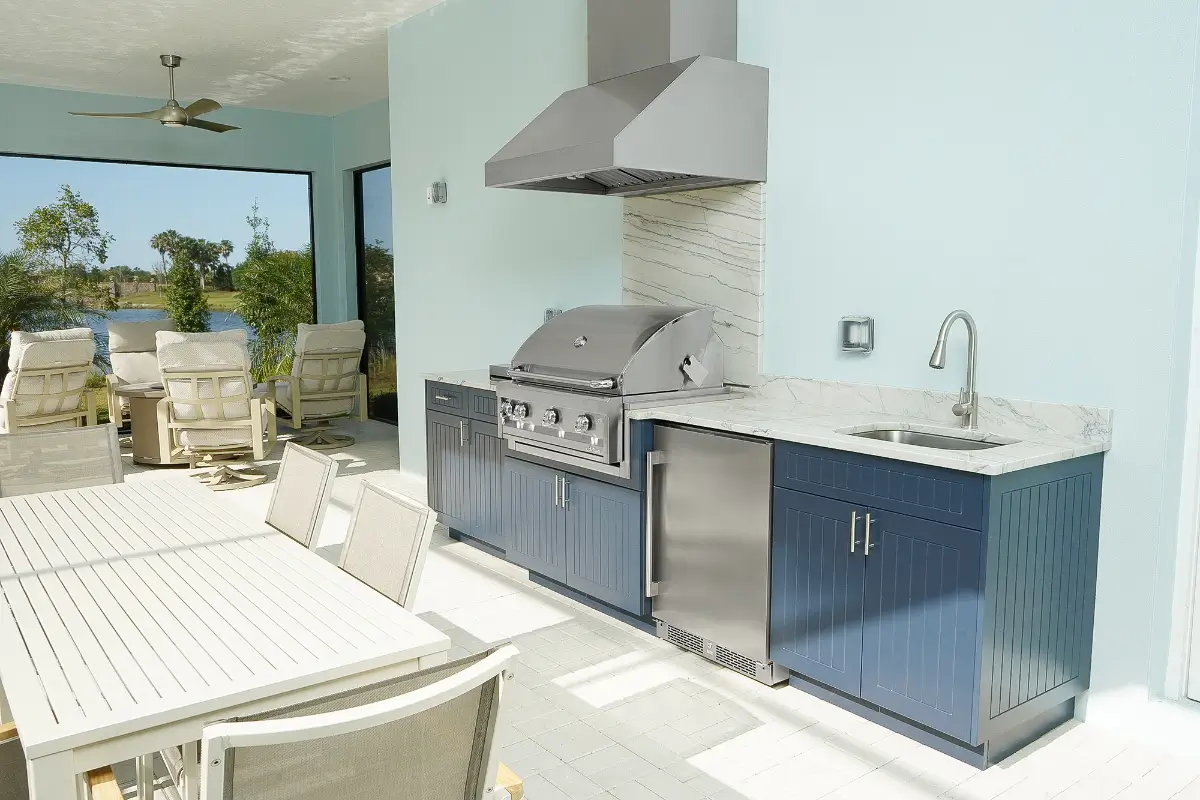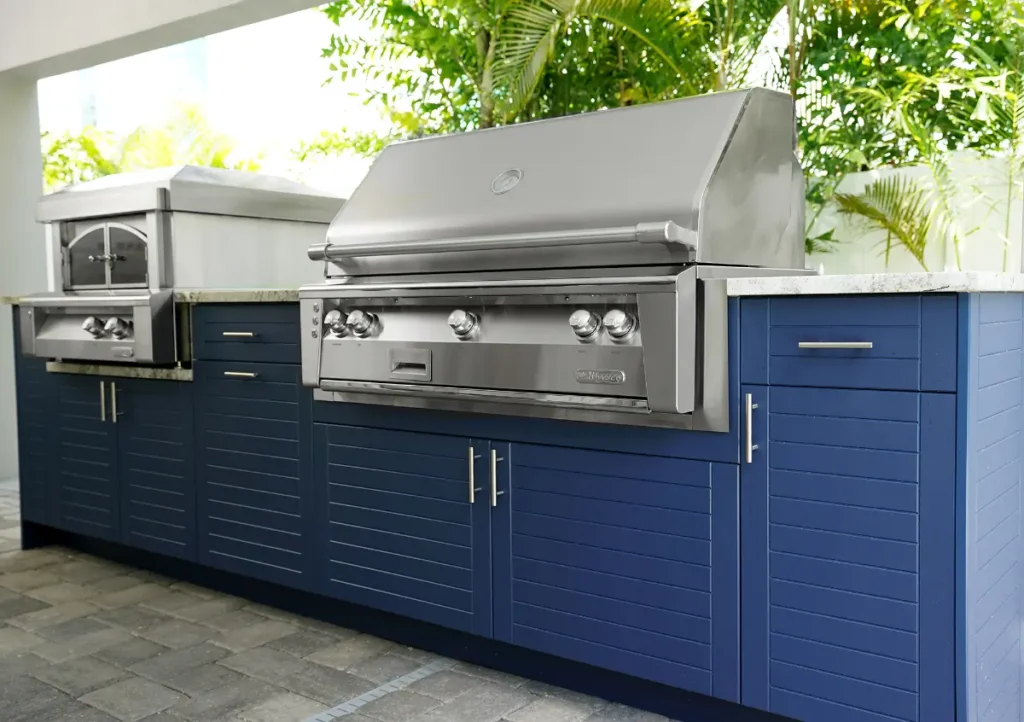
What to Know About Ready-to-Assemble Outdoor Kitchens
Ready-to-assemble (RTA) outdoor kitchens have carved out a space in the outdoor living market as a convenient solution for homeowners who want a faster path to outdoor cooking and entertaining. They promise ease, speed, and often a lower price tag than fully custom designs. But like any significant investment in your home, RTA kitchens come with trade-offs and considerations that shouldn’t be overlooked.
At Calico Outdoor, we specialize in fully customized outdoor kitchen solutions that are tailored to the Jacksonville climate and your specific lifestyle. However, we also understand the appeal of RTA kits, and we often help customers make the right call by walking them through the pros, cons, and realities of assembly, durability, and long-term use.
Table of Contents
What Does “Ready-to-Assemble” Actually Mean?
The term can be a little misleading. “Ready-to-assemble” suggests that you’re dealing with a plug-and-play solution, but most kits still require a fair amount of work. That might include setting a level base, anchoring the units, connecting gas or electric lines, and sometimes making modifications onsite. While the cabinetry or framing might arrive pre-cut and labeled, this doesn’t mean it’s a zero-effort installation.
Typically, RTA kits come in flat-pack boxes and include materials like steel framing, cement board panels, and sometimes prefinished countertops or cladding. Assembly instructions vary by brand. Some are intuitive; others feel like you’re building furniture without all the tools or fasteners included.
The key takeaway: it’s not as simple as snapping a few pieces together. Unless you’re especially handy, you may still need to hire a contractor or technician for part of the job.
Speed and Convenience — But With a Catch
One of the biggest reasons homeowners gravitate toward RTA kitchens is timeline. Custom projects can take several weeks for design, manufacturing, and installation. RTA kits can often be shipped in a matter of days and installed within a weekend or two. This is especially appealing during spring and early summer when outdoor entertaining season ramps up.
However, the promise of speed often collides with reality once installation starts. Kits may arrive missing pieces. The ground may not be level. Instructions may not account for real-world site conditions. And if you want to integrate a sink, grill, or refrigerator, you’ll still be dealing with licensed tradespeople for utility hookups.
That convenience quickly fades if you run into problems that weren’t spelled out in the product description.
Material Quality Varies Wildly
RTA outdoor kitchens aren’t all created equal. One of the biggest variables is material quality. Entry-level kits sometimes use galvanized steel that can rust in humid or coastal environments. Jacksonville’s salty air is especially hard on cheap metal. Other kits might rely on painted MDF panels or composite boards that aren’t designed to withstand rain or UV exposure.
Higher-end RTA brands tend to use stainless steel framing or high-density concrete panels, which hold up better over time. But even then, finishes, hinges, and screws can be weak points that fail long before the structure itself.

Before buying any RTA kitchen, ask questions about the materials. Look for corrosion resistance, weather ratings, and warranty support. If the answers aren’t clear, there’s probably a reason.
Design Flexibility is Limited
RTA kitchens follow a modular format, which makes manufacturing and shipping more efficient. That also means your layout options are limited to whatever configurations the brand offers. If your outdoor space is narrow, has tight corners, or needs a specific grill size, you might struggle to find a kit that fits perfectly without modification.
Some kits allow minor flexibility by letting you rearrange components, but true customization is rare. You won’t be able to angle corners, build around posts, or incorporate unique appliances without going off-plan. That might be fine for a basic setup, but it becomes a roadblock if you’re aiming for a more seamless, built-in aesthetic.
Custom builds may take longer, but they let you design around the space rather than forcing the space to adapt to the kit.
Installation Still Requires Skill
Even though RTA kitchens skip the design phase and most of the heavy construction, you still need to know what you’re doing. Leveling the frame, securing the panels, and aligning the appliances take precision. An uneven base can ruin the entire structure over time.
Also consider the utilities. Adding a gas grill? You’ll need a licensed plumber. Running electrical to a fridge or lighting? That means permits and inspections. If you’re not experienced with these trades, budgeting for professional help is a must.
Too many homeowners assume “DIY-friendly” means they won’t need support. More often than not, the opposite ends up being true.
Ongoing Maintenance and Longevity
Outdoor kitchens live in harsh conditions. Rain, heat, grease, UV rays—they all take a toll. RTA kitchens that use subpar materials can start showing wear within a year or two. Hinges rust. Doors sag. Panels crack. Replacing parts might not be easy, especially if the brand doesn’t offer good post-purchase support.
Well-built custom kitchens, especially those using marine-grade stainless steel or masonry, are designed with longevity in mind. You can expect 10 to 20 years of use with minimal maintenance. With RTA kitchens, lifespan often comes down to how well the materials were chosen and how carefully the kit was installed.
Cost vs. Value
At first glance, RTA kits seem like a budget-friendly option. A basic kit might run a few thousand dollars less than a custom install. But once you factor in the cost of tools, added labor, potential utility work, and repairs down the line, that initial savings can shrink fast.
Value isn’t just about the upfront cost—it’s about how well the kitchen performs over time and how much enjoyment it brings to your space. A low-cost kitchen that falls apart in a few years isn’t really a good deal. But a well-installed RTA kit using quality materials can absolutely serve its purpose for the right kind of project.
When an RTA Kitchen Makes Sense
For second homes, rental properties, or customers who just want a simple grill island without complex features, RTA kitchens can be a smart choice. They fit smaller budgets, tighter timelines, and straightforward layouts. As long as expectations are realistic and the kit comes from a reputable brand, they can offer good functionality without overextending the budget.
However, if you’re building your dream backyard kitchen, entertaining regularly, or want something built to last through years of Florida summers, a custom solution is going to offer better long-term value, higher quality, and more design freedom.
Final Thoughts
Ready-to-assemble outdoor kitchens have earned their spot in the market for a reason. They fill a gap between grill carts and full-scale builds, offering a middle ground that can be perfect in the right scenario. But they aren’t as simple or cheap as some marketing might suggest.
Think carefully about how you plan to use your outdoor kitchen, how long you want it to last, and whether the design limitations work for your space. If you’re in Jacksonville or the surrounding area and unsure where to start, Calico Outdoor is always available to talk through options and help you figure out what kind of kitchen makes the most sense for your home.
